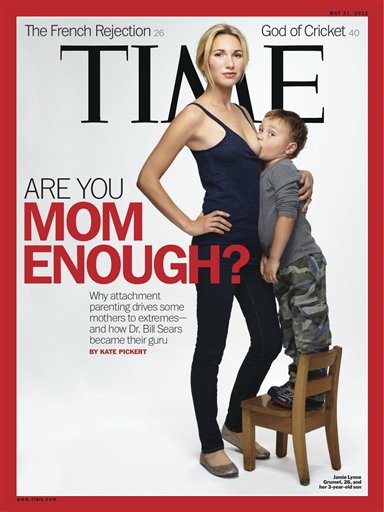For many, the photograph of a sexy blond mother nursing her almost 4-year-old son was provocative enough.
But the headline “Are you Mom Enough?” slapped above the current Time Magazine cover story about the latest trends in parenting stung, and has sparked a heated debate about the modern relationship between mom and baby.
The article is burning up chat rooms and mommy blogs. On The Bump, a pregnancy and parenting website, thousands of moms buzzed on the topics of breast-feeding past the first year, children sleeping in the parental bed, and wearing baby in a sling _ the cornerstones of what’s called “attachment parenting.”
“If they can ask for it and lift up your shirt, it’s time to stop feeding them on the breast,” read a post on The Bump by Elizabeth.
Another poster, Trinity, praises the cover girl. “I would high-five that woman,” she says. I don’t plan on breast-feeding past one year, but I do know it’s perfectly normal to do so, especially in other cultures. Americans freak out. But hey, that kids’ probably got an immune system of steel!”
While the Time cover is certainly provocative, it’s also somewhat misleading, as the article focuses largely on the life of attachment parenting guru William Sears and the impetus for his 1992 “The Baby Book” book, which has sold 1.5 million copies and celebrates its 20th anniversary this year. The Orange County, Calif., pediatrician believes children are more likely to thrive both physically and emotionally when reared in a child-centered environment that includes breast-feeding long past the first year and sharing a family bed.
But it is that photo of a svelte, beautiful, mother of four pictured with her suckling preschooler and without so much as a centimeter of baby weight that some moms find particularly inflammatory.
“(The cover) is purposefully divisive and rude,” says Janna Lipman Weiss, a 40-year-old Walnut Creek, Calif., mother of two. The former molecular biologist referenced the Sears book during her daughters’ early years, breast-feeding for four and a half years all together. She found other tips helpful, too. Wearing her babies on her back soothed them, she says.
But not everything Sears preaches worked for her.
“My first one didn’t like being touched all the time so even if I wanted to follow Sears, my daughter wasn’t having it,” Lipman Weiss says. Also, Sears’ suggestion to nurse around the clock and somehow deal with the accompanying bleary-eyed sleeplessness was particularly irksome _ and impossible _ for her.
“I don’t think my comments about that are appropriate for a family newspaper,” Lipman Weiss says.
Breast-feeding has always been a controversial topic. Questions like “How old is too old?” or “Are you a bad mom if you don’t do it?” have long plagued anxiety-ridden new mothers, says Shannon Guyton, the Los Angeles-based site director for The Bump.
But one thing’s for sure, she says.
“Every mom who’s breast-fed knows that Time photo is not an accurate view of breast-feeding,” she says. “There’s not a single sexy thing about it. You know what your limits are and you do what you can. Of course you’re mom enough.”
According to a 2006 study by the Centers for Disease Control, only 13.6 percent of babies in the U.S. are exclusively breast-fed through the first six months of life, which is what the American Academy of Pediatrics recommends. The World Health Organization recommends a full year of exclusive breast-feeding.
In the Bay Area, the initiation rate of breast-feeding _ how many moms are breast-feeding when they leave the hospital with baby _ is 95 percent, according to Nancy Held, a lactation consultant, registered nurse and vice president of Day One Centers, which has locations in Palo Alto and Walnut Creek.
“That’s very high,” says Held. “Then we have people going back to work and pumping and things drop off.”
Held says the thought of anyone breast-feeding for a year makes her happy. Everyone hears stories about women who are still breast-feeding their 5-year-olds, but that is hardly the norm, she says.
“I think to be clear the image was used by Time Magazine for shock value,” Held says. “Dr. Sears has been around for 20 years so there’s nothing new about him. Parents have become much more anxious in the past 10 years so our job is to support them and give them the confidence that only they can decide what’s right for their baby.”
There are varying degrees of attachment parenting: Some believers would never leave their babies for a date night or let them so much as utter a cry without running to their side. Others take a more moderate approach, believing in the research-based studies that show how skin-to-skin contact improves the emotional well-being and development of an infant and helps increase mom’s milk production.
Naysayers claim that extreme attachment parenting such as breast-feeding into toddlerhood _ or Sears’ gentle prodding that staying home with baby is best _ threatens to rewind the feminist movement.
Samantha Cook, a freelance educator and Oakland, Calif., mother of three, disagrees. She has been a proponent of the attachment parenting style a decade and believes it is about creating strong family bonds.
“I think it’s empowering for women to be able to parent in the way we want,” says Cook, 35. But Cook admits she has received criticism from friends, particularly on the East Coast, for her parenting choices, which include breast-feeding each child for a minimum of two years and co-sleeping with her 7- and 9-year-old boys.
“That’s when our king sized bed comes in handy,” she says.
Send questions/comments to the editors.


